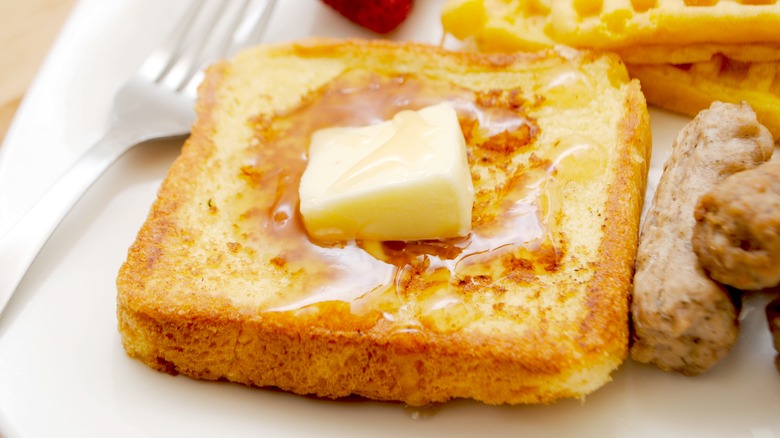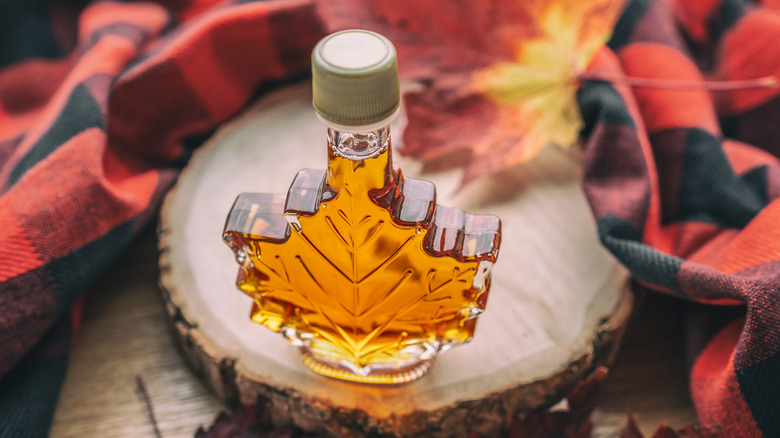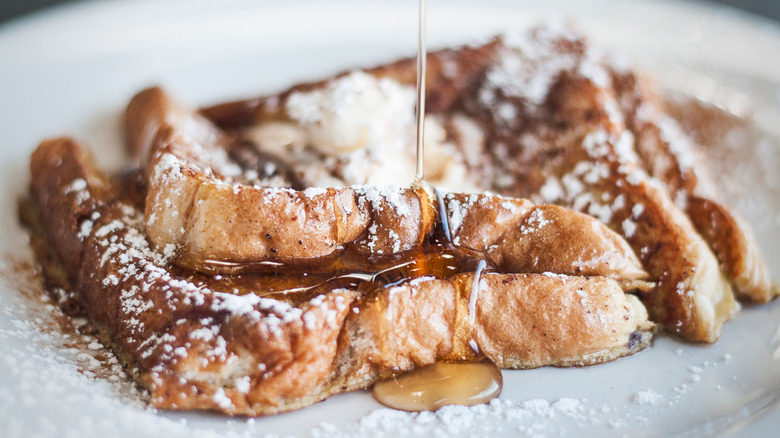Golden Bread: What Makes Canadian-Style French Toast Unique
If you're looking for a way to revive that day-old, stale bread in your cupboard, look no further than French toast. Your breakfast can become even more exciting if you borrow from global cuisines to dress it up in different ways. Germans enjoy a French toast casserole, called arme ritter auflauf, while the Scottish might sandwich sausages between two slices of the fluffy, custardy bread. One of the simplest and tastiest variations to try out is Canadian golden bread.
In Quebec, golden bread ("pain dore" in French) is a beloved treat, suitable for the cold weather that the region is known for. This hearty breakfast is rather similar to classic French toast. Both start off with sliced bread soaked in a sweetened mixture of eggs and milk. The bread is pan-fried, then finished with syrup and sweet toppings before serving.
The thing that really sets Canadian-style golden toast apart is its color. After the toast has been fried, topped with syrup, and served, it takes on a golden hue. That color partially comes from the egg yolks in the custard mixture but is mostly owed to the amber maple syrup that is so popular in Canada. Tossing aside generic pancake syrup and springing for grade A, 100% pure Canadian maple syrup is what really gives your French toast a taste of Quebec. Most pain dore recipes also call for cinnamon and sometimes brown sugar, which are popular but optional additions to basic French toast.
Only real Canadian maple syrup will do
Maple syrups are classified into four different types, each with different colors and flavors. Generally, the darker the color, the stronger the flavor, and amber syrup veers towards the lighter end of the spectrum. It has a rich, classic maple flavor that makes it a great all-purpose choice, and it's a must-use for pain dore. The syrup lends its color to this version of French toast, while the rich and authentic maple flavor complements the eggy bread.
It's no wonder why maple syrup defines Canadian French toast. The country produces 85% of all maple syrup in the world, with 72% coming from Quebec alone. When shopping for amber maple syrup to make golden toast, don't be fooled by generic pancake syrup or "table syrup" brands. These products are mostly composed of corn syrup and artificial flavorings — in fact, they might not contain any real maple syrup at all.
Making real maple syrup involves boiling down maple sap, and this long process produces complex flavors that are unlike anything else. To make sure your golden toast looks and tastes like it's supposed to, look for Grade A amber-style maple syrup that was made in Canada. Syrups with Grade A labeling must be 100% pure, with no additives whatsoever, so you know you'll be getting the good stuff.
Golden toast is a Canadian lumberjack staple
Most varieties of French toast, including pain dore, can be prepped the night before. Just mix up the custard and leave the bread to soak in the fridge overnight, then quickly pan-fry it in the morning. This convenience factor, coupled with the nutritious ingredients in the dish — eggs, dairy, and hearty, carb-rich bread — may have led to the popularity of golden bread.
One story about golden bread states that it gained its popularity at Canadian logging camps. Before workers headed out for the day, they needed a filling breakfast so that they would stay full while doing strenuous and intensive work in the cold outdoors. The sweet, syrupy bread was an easy way to load up on a hearty meal before the workday. Add some Canadian bacon on the side, and you have a breakfast fit for a lumberjack.
The only hard part of making pan dore is shelling out cash for the best syrup. Authentic maple syrup can get pretty pricey, and it'll need to be stored in the fridge for maximum freshness. But if you want to try your French toast Canadian-style, there's no substitute for the real deal. If you're willing to spend some more coin for better results, why not add some Canadian whiskey to your custard mix, too? Canada is known for producing some excellent labels, and a shot or two in your French toast gives it an extra boost of warm, sweet, caramel-y goodness.


